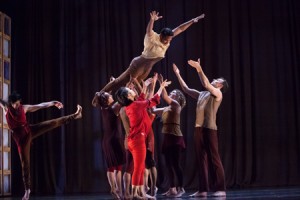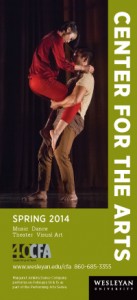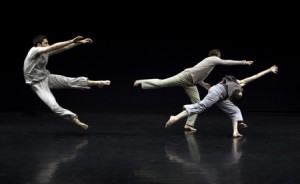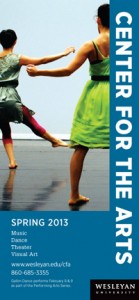CFA Arts Administration Intern Chloe Jones ’15 talks to Wesleyan DanceLink Fellow Cynthia Tong ’14 about Margaret Jenkins Dance Company, who will be performing the New England premiere of “Times Bones” on Friday, February 14 and Saturday, February 15, 2014.
In 1970, a young Margaret Jenkins returned home to San Francisco where her family had lived for generations. She had been studying with dance legend Merce Cunningham in New York and brought back with her the new and exciting ideas emerging in the field of modern dance.
The founding of the Margaret Jenkins Dance Company in 1973 was a milestone for the city of San Francisco, signaling the spread of the American avant-garde movement that had begun on the east coast with Mr. Cunningham and his contemporaries.
Although the company has for decades been at the heart of the local arts scene in San Francisco, the company has also gained international acclaim. In the late 1970s, the Margaret Jenkins Dance Company began touring the United States on a regular basis, and has since then traveled throughout Europe and Asia to perform.

This weekend their journey brings them back to Wesleyan University for the New England premiere of Times Bones, a fitting venue given that this season is the 40th anniversary for both Margaret Jenkins Dance Company and the Center for the Arts. [Margaret Jenkins Dance Company previously performed at Wesleyan in April 1990. This weekend is also the first performance by Margaret Jenkins Dance Company in New England since 1998.]
In thinking about a way to commemorate the 40th anniversary of the company, Ms. Jenkins began revisiting past works. She reread journals and notes, mined her extensive archives, and examined all 68 works recorded on videotape, all the while asking, “What were the stories in those pieces that were still untold?”
To use the language of the ancient Egyptian myth of Osiris that partly inspired her process, she was gathering the “bones” of her repertory. From these fragments, she has choreographed a new whole: the evening-length piece titled Times Bones.
But the work is not as simple as a dance down Memory Lane. The hope in returning to previous choreography was never to go back in time, but rather to push forward.
“The piece as a whole is aiming to find a new beginning,” says Wesleyan DanceLink Fellow Cynthia Tong ’14, who worked closely with Ms. Jenkins and the members of the company as an intern in San Francisco this past summer. “It’s a look toward the future.”
Ms. Tong describes the studio where the company rehearses as a safe space with a positive atmosphere, a place where experimentation and productivity go hand in hand. “Work was getting done while ideas were being thrown around,” she recalls.
Like many of her former works, Times Bones is the product of a deeply collaborative process. As Ms. Jenkins explains, “The role of the dancers in making my work is absolutely substantive and primary to my process.”
The aura of collaboration in the studio invites the dancers to speak up and share their opinions and ideas. “She’s very open to hearing what other people have to say,” Ms. Tong remarks.
The role of the interpreter is crucial to her work. While choreographing she asks her dancers to interpret various prompts and experiments, and in performance she invites the interpretations of the audience, never declaring one right or another wrong.
“She believes that when audiences go see her work there are a hundred different possible interpretations and that is part of her goal,” says Ms. Tong. “The audience is the final collaborator.”
Cynthia Tong will give a pre-performance talk on Friday, February 14, 2014 at 7:30pm in the CFA Hall, 287 Washington Terrace, Middletown. Margaret Jenkins will teach a free master class on Saturday, February 15, 2014 at 11am in the Bessie Schönberg Dance Studio, 247 Pine Street, Middletown.
Margaret Jenkins Dance Company: Times Bones
New England Premiere
Friday, February 14 and Saturday, February 15, 2014 at 8pm
CFA Theater, 271 Washington Terrace, Middletown
$25 general public; $21 senior citizens, Wesleyan faculty/staff/alumni, non-Wesleyan students; $6 Wesleyan students
Spend Valentine’s Day at the CFA – click to view special “prix fixe” menus that will be available at five Middletown restaurants for dinner on Friday, February 14, 2014.










